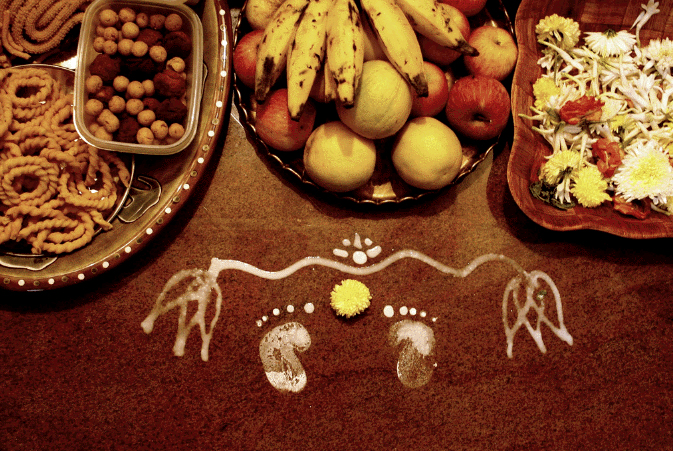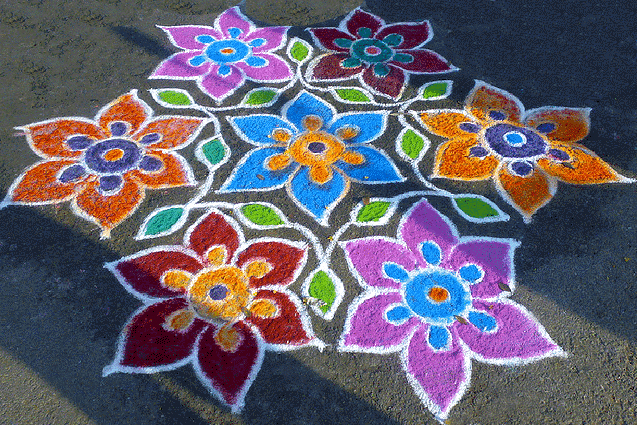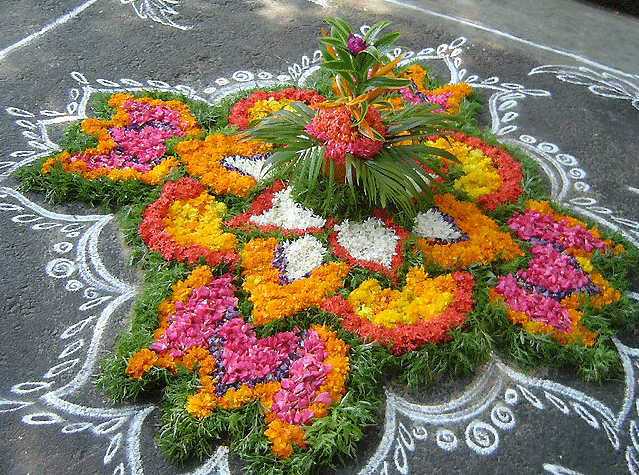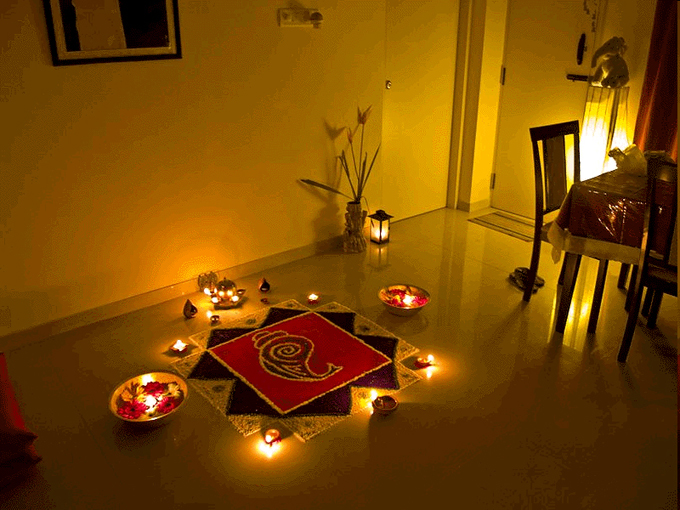
|
|
|
|
BY: SUN STAFF

Janmastami Rangoli Feb 17, 2010 — CANADA (SUN) — A study of the historical, spiritual and cultural elements of Vedic design. In our last segment of this series, after briefly discussing the fundamental designs of yantra and mandala, we began talking about the artistic practice of creating designs on the floor, known as rangoli in North India, or kolam in South India. The creation of these artistic works is part of daily devotional practice in the asrama, as well as being part of elaborate pujas and yajnas in the temple. As with all things, the beauty of creative artworks is a reflection of Sri Krsna, who is Himself the greatest Artist and Craftsman: "He is most expert in all kinds of artistic enjoyment (He lives wonderfully at the topmost height of artistic craftsmanship), He is cunning and clever in the art of performing various types of work simultaneously, He is always joyful and untouched by any distress, and He is always self-satisfied and peaceful."
There are many pictures found depicting Krsna in the act of some artistic creation. Sometimes His artistic works are being produced directly onto Radharani, as He arranges Her hair, winding beautiful loops of gems and flowers through Her braids. Other times He is painting designs onto Her hands and feet, like auspicious symbols representing Her glorious potencies, or artistic designs and scrollwork. Krsna is also expert at building constructions, creating forts with the cowherd boys, or bent-wood bowers in the groves of Vrindavan, decorated with blooms and creepers. Some of these constructions in the forests of Vraja are very simple, while others were extremely opulent: "In the shade of a parijata tree in Vrindavana forest, in a jewelled pavilion, with a splendid floor of jewels and a roof of beautiful flowers, I see Lord Hari, seated with Radha on silk cushions and flowers, and asking questions of Their glorious gopi maidservants."

Sri Sri Radha Krsna's jeweled floor and flower-covered roof described above are surely among the sources of inspiration for rangoli and kolam design motifs. Jewel-like surfaces in rangoli are often attained by mixing colored powders with sand, the silica providing a jewel-like shine. Other rangoli and kolam motifs are created with powders used to paint an image of flowers or designs, while other patterns are produced using fresh flowers to fill-in the geometric spaces. Generally, North Indian rangoli uses colored powders made of ground rice or flour colored with natural substances like turmeric and vermillion. Rice flour, either dry or wet, is applied to kolam in South India. Sometimes kolam are produced with a mixture of sand, lime and a wet red soil known as chemman in Tamil, and this is often used for the borders. The use of lime is not favored as a traditional medium, however, because it doesn't provide a nice foodstuff for the insects and birds, like rice powders do.

In the Visnu-dharmottara Purana, Chitra-sutra, we find instructions on how to prepare the ground before painting the Bhumichitra yantra for the Navagraha, and these preparatory instructors are typically used for rangoli work, as well. Preparation for kolam designs is very similar. First the floor area is swept, then washed, with all the excess water wiped off. This helps to dry powders to remain adhered to the surface for as long as possible. Fresh applications are often done morning and evening, to touch-up any spots that have become smudged in the design. Design motifs vary greatly from region to region, and depending on the festival being celebrated. On Sri Krsna Janmastami, particularly in Tamil Nadu and Karnataka, it is traditional to make an ornamental design of Krsna's two baby feet at the entrance to an asrama or temple. Designs are often framed in decorative borders, not unlike the border designs around the yajna kund, featured previously. Indian households often create intricately unique rangoli designs for every festival occasion, rarely repeating the same design twice. These spiritual works of art appear in front of the asrama, at the corners of the house, and in the centers of some rooms, where they are lighted with dipa lamps and adorned with bhoga and flowers, offered to Their Lordships.

As previously mentioned, many women awake each morning and begin to prepare the household for the day by creating a fresh rangoli outside, by the door. This is often followed by Tulsi puja, and we commonly see rangoli patterns around Tulsi's wooden pot. In Vedic times, rangoli and kolam were practiced as a regular element of daily worship in temples, and were later incorporated into the sakta-agamaas. There, Sri Cakra yantra is offered to Devi, and many forms of tantric art appear to have grown out of that practice. The Sri Charka is a very traditional kolam pattern, and Lord Sudharshana is worshipped in yantra form, embodied in a kolam pattern.

Sudarshan Chakra In ancient times, there lived a pious man named Sudharma. While meditating, his concentration began to get disturbed, and he went to the sage Vairata, who lived in a nearby forest, to get advice. Prostrating himself before the rishi, Sudharma asked for a solution to his problem. The sage instructed him to go to the edge of the forest, where he would find a supply of white quarry stones. These he was directed to smash down into a powder, using the powder to create auspicious designs on the threshold of his kutir. This would keep away the disturbing elements that were interrupting his meditation. Sudharma followed this advice, thereafter rising every morning to wash and clean the threshold of his asrama, decorating it with auspicious symbols of the sun, moon, swastika, Tulsi Vrindavan, and the Lord's lotus feet. Observing the great benefits this brought to Sudharama, his neighbors followed suit, and began propagating the art of rangoli and kolam with great religious fervor.
| |